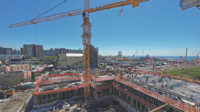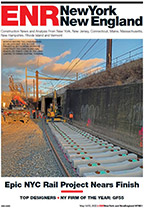Tunnels have long snaked through the bedrock beneath New York, carrying people and water, but now the underground labyrinth is growing, with multiple projects under way.
�Some of this work has been in the planning stages for ages but there has been a major push to modernize New York City�s infrastructure over the last decade,� says Gary A. Almeraris, vice president of Skanska USA Civil Northeast of Whitestone, N.Y. He reports the city and transportation authorities have championed the activity, and monies from the federal government, bond initiatives and local dollars have fueled the projects.
�All of the owners have been lobbying and soliciting outside funding sources, and they all finally came through,� adds Paul Scagnelli, executive vice president and chief engineer at Schiavone Construction Co. of Secacus, N.J., reporting his firm is busy but has no above ground work.
�Everyone wants these projects done as soon as possible, so we have a flurry of underground activity,� Almeraris says. �This is good news for the New York construction industry, and we expect the underground market to help us carry the rest of the construction industry through these very tough times.�
Skanska Civil has multiple subterranean projects under construction, including MTA Capital Construction�s Fulton Street Transit Station, the Second Avenue subway and the Seventh Line extension.
�What we have is a Godsend for the construction market in New York, because we are one of the biggest users of contractors,� says Michael Horodniceanu, president of MTA Capital Construction in New York. �With the work for the ARC (Access to the Region�s Core ) coming in, that will make it even better. People are hungry and people are bidding. I expect to continue to get good prices.�
A joint venture among Schiavone; J.F. Shea Construction of Walnut, Calif.; and Skanska received the $258.7 million contract for the Palisades segment of the $8.7 million, 9-mi Access to the Region�s Core (ARC), a project of NJ TRANSIT and the Port Authority of New York & New Jersey. The twin Trans-Hudson Express Tunnels will bring additional NJ TRANSIT trains to Manhattan�s Penn Station. Work on the Palisades tunnel contract is expected to begin this summer.
The apparent low bidder for the design and construction of the $583 million Manhattan Tunnel segment is a joint venture between Barnard of New Jersey, part of Barnard Construction of Bozeman, Mont., and Judlau Contracting of College Point, N.Y. Five companies have been prequalified to design and build the third tunnel under the Hudson.
Ferreira Construction of Branchburg, N.J., is working on a $13.6 million underpass at Tonnelle Ave. for the Trans-Hudson Express Tunnel.
The CM Consortium, a joint venture consisting of Tishman Construction Corp of New York, Parsons Transportation Group, and ARUP, all with offices in New York, is providing project controls and construction management services for the Trans-Hudson Tunnel. The size and scope of the underground projects has led to many joint ventures.
Joint ventures provide a powerhouse combination of expertise, experience and collaboration to design and build these massive, multi-year projects,� says Jay Badame, president and COO of Tishman Construction of NY/NJ/PA in a written response to questions.
MTA projects abound?MTA Capital Construction is keeping five tunnel boring machines busy boring 12 mi of tunnel and will add two more early in 2011 when the next East Side Access phase begins.
�You don�t start big projects in bad times, only in good times, because that�s when people have the appetite of funding stuff like this,� Horodniceanu says. �But the economy changed, things got problematic, and we got good bids.�
More work is coming, including finishing and systems contracts. Horodniceanu expects those bids will remain competitive. MTA plans to award most contracts by the end of 2012, with work wrapping up by 2016 on all projects.
�When you have financial difficulty, it�s incumbent on our government to look at how to keep the economy perking, and large capital construction projects have proven over and over again as catalysts for economic recovery,� says Horodniceanu, adding that MTA is putting thousands of people to work on the projects. The current generation receives jobs, he says, and future generations benefit from the improved infrastructure.
The various projects happened for different reasons, Horodniceanu adds.
The $7.3 billion East Side Access began in 1999 to increase the number of people Long Island Railroad could bring into Midtown Manhattan. Granite/Traylor/Frontier-Kemper Joint Venture, a partnership among Granite Construction of Watsonville, Calif.; Traylor Bros. of Evansville, Ind.; and Frontier-Kemper of Pelham, N.Y., received the $659 million Queens Bored Tunnels and Structures contract. Dragados/Judlau, a joint venture between Dragados USA of New York and Judlau, is working on the $450 million Manhattan tunnel and the $779 million Manhattan Structures package.
The $2.1 billion Seventh Line extension aims to better serve the Jacob K. Javits Convention Center. S3II Tunnel Constructors, a joint venture among Shea, Schiavone and Skanska, received the $1.25 billion tunneling contract. It has bored 12,000 li ft of tunnel connecting the Port Authority Bus Terminal at 42nd Street to 34th St.
The events of September 11, 2001, created a push for the revival of lower Manhattan, Horodniceanu says, leading to a need for more infrastructure.
The $4.45 billion Second Avenue Subway project will provide a two-track line along Second Avenue from 125th Street to the financial district, which is anticipated to decrease overcrowding and delays on the Lexington Avenue line. The first of four phases entails building two tunnels, totaling 15,000 li ft, from 96th Street to 63rd Street and Third Avenue, with new stations at 96th, 86th and 72nd streets and a refurbished station at 63rd Street. S3 Tunnel Constructors, a joint venture between Skanska, Shea and Schiavone, received the $370 million tunneling contract and have begun the work.
The desire to enable people to transfer among the multiple subway trains converging in Lower Manhattan formed the genesis for the $1.4 billion Fulton Street Transit Station, Horodniceanu says. Skanska has finished a $133 million design-build, cut-and-cover project, constructing the 400-ft-long, 29-ft wide Dey Street pedestrian passageway, linking the Fulton Street center with the World Trade Center PATH station. Skanska also is completing the foundations, scheduled to wrap up this fall, and preparing the mezzanines for the A and C subway lines, slated to finish in 2013, under separate $69 million and $120 million contracts respectively.
�This work is similar to changing a tire on a bike while you are riding the bike, Horodniceanu says. �The trains are running while we do the work. We can expect to finish it on time or ahead of time.�
Horodniceanu just received bids for the $176 million, 27,000-sq-ft transit center building, which came in below estimates. A joint venture between Plaza Construction of New York and Schiavone received the contract.
�What happened is we received bids from all of the major contractors, and in other times, they wouldn�t touch us,� Horodniceanu says. �Now they have no work, so they jump at the possibility to work for us.�
Underground Projects
Several of the city�s high-profile underground projects have completed tunneling, at least for the time being, or do not require a tunnel-boring machine.
div id="articleExtras"






